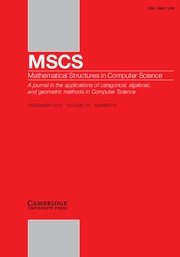Crossref Citations
This article has been cited by the following publications. This list is generated based on data provided by Crossref.
Bundgaard, Mikkel
Hildebrandt, Thomas
and
Godskesen, Jens Chr.
2007.
Modelling the Security of Smart Cards by Hard and Soft Types for Higher-Order Mobile Embedded Resources.
Electronic Notes in Theoretical Computer Science,
Vol. 194,
Issue. 1,
p.
23.
Selinger, Peter
and
Valiron, Benoît
2008.
Foundations of Software Science and Computational Structures.
Vol. 4962,
Issue. ,
p.
81.
Lampis, Michael
Ginis, Kyriakos G.
Papakyriakou, Michalis A.
and
Papaspyrou, Nikolaos S.
2008.
Quantum Data and Control Made Easier.
Electronic Notes in Theoretical Computer Science,
Vol. 210,
Issue. ,
p.
85.
Arrighi, Pablo
and
Dowek, Gilles
2008.
Rewriting Techniques and Applications.
Vol. 5117,
Issue. ,
p.
17.
Delbecque, Yannick
and
Panagaden, Prakash
2008.
Game Semantics for Quantum Stores.
Electronic Notes in Theoretical Computer Science,
Vol. 218,
Issue. ,
p.
153.
Selinger, Peter
and
Valiron, Benoît
2009.
Semantic Techniques in Quantum Computation.
p.
135.
Nyman, Peter
2009.
Quantum Interaction.
Vol. 5494,
Issue. ,
p.
158.
Vizzotto, Juliana Kaizer
Librelotto, Giovani Rubert
and
Sabry, Amr
2009.
Formal Methods: Foundations and Applications.
Vol. 5902,
Issue. ,
p.
321.
LAGO, UGO DAL
MASINI, ANDREA
and
ZORZI, MARGHERITA
2009.
On a measurement-free quantum lambda calculus with classical control.
Mathematical Structures in Computer Science,
Vol. 19,
Issue. 2,
p.
297.
Vizzotto, Juliana Kaizer
Du Bois, André Rauber
and
Sabry, Amr
2009.
Logic, Language, Information and Computation.
Vol. 5514,
Issue. ,
p.
379.
Arrighi, Pablo
and
Dowek, Gilles
2010.
Programs, Proofs, Processes.
Vol. 6158,
Issue. ,
p.
21.
Dal Lago, Ugo
Masini, Andrea
and
Zorzi, Margherita
2010.
Quantum implicit computational complexity.
Theoretical Computer Science,
Vol. 411,
Issue. 2,
p.
377.
Baez, J.
and
Stay, M.
2010.
New Structures for Physics.
Vol. 813,
Issue. ,
p.
95.
Ying, Mingsheng
2010.
Quantum computation, quantum theory and AI.
Artificial Intelligence,
Vol. 174,
Issue. 2,
p.
162.
Delbecque, Yannick
2011.
Game Semantics for Quantum Data.
Electronic Notes in Theoretical Computer Science,
Vol. 270,
Issue. 1,
p.
41.
Díaz-Caro, Alejandro
Arrighi, Pablo
Gadella, Manuel
and
Grattage, Jonathan
2011.
Measurements and Confluence in Quantum Lambda Calculi With Explicit Qubits.
Electronic Notes in Theoretical Computer Science,
Vol. 270,
Issue. 1,
p.
59.
Dal Lago, Ugo
Masini, Andrea
and
Zorzi, Margherita
2011.
Confluence Results for a Quantum Lambda Calculus with Measurements.
Electronic Notes in Theoretical Computer Science,
Vol. 270,
Issue. 2,
p.
251.
Dal Lago, Ugo
and
Faggian, Claudia
2012.
On Multiplicative Linear Logic, Modality and Quantum Circuits.
Electronic Proceedings in Theoretical Computer Science,
Vol. 95,
Issue. ,
p.
55.
James, Roshan P.
and
Sabry, Amr
2012.
Information effects.
ACM SIGPLAN Notices,
Vol. 47,
Issue. 1,
p.
73.
Assaf, Ali
and
Perdrix, Simon
2012.
Completeness of algebraic CPS simulations.
Electronic Proceedings in Theoretical Computer Science,
Vol. 88,
Issue. ,
p.
16.

